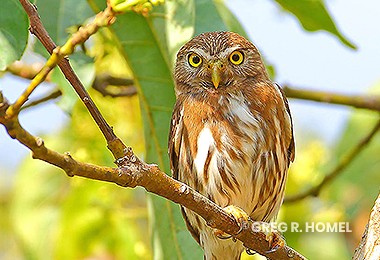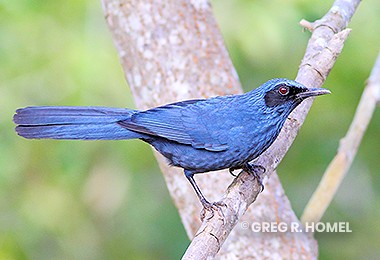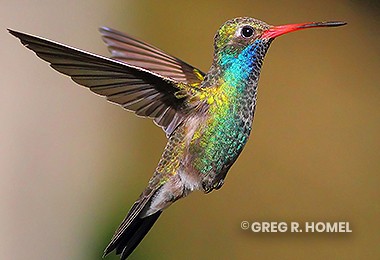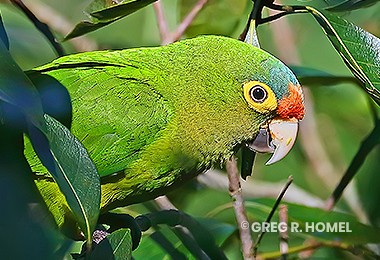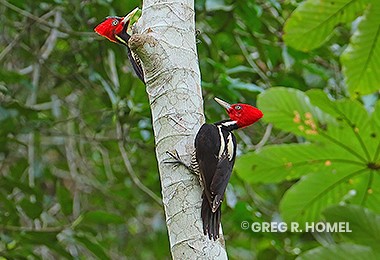The Birds of Paradise Tour
Birds to Watch: 300
Location: Puerto Vallarta » Jalisco
An Introduction to the Joys of Tropical Birding for Enthusiastic First Timers or Casual Birders within the Vallarta Region
Join Birding in Mexico to partake in this incredibly enjoyable full day tour centering on the sinuous meanderings of the verdant Rio Ameca as we crisscross the border of Jalisco and Nayarit—so close but yet so far from the touristy crowds of Puerto Vallarta!
Tour Description
The Bahía and Valle de Banderas are located on the central pacific coast of Mexico, the latter bifurcated by the meandering perennial flow of the Rio Ameca.
The bay is bounded by Cabo Corrientes on the South, Valle de Banderas on the East, Punta de Mita on the north and the Islas Marietas National Park and Marine Reserve offshore to the west.
Introduction to the Birds of the Area
Encounter, close up views of birds from a multitude of tropical bird families—including possible Tinamous, Chachalacas, Guans, Whistling-Ducks, Jacanas, Elegant Quail, Cuckoos, Hummingbirds, Limpkin, Pelicans, Ibises and Spoonbill, Storks, Frigatebirds, Boobies, Ferruginous Pygmy-Owl, Trogons, Caracaras, Parrots, Parakeets and Macaws, Motmots, Woodcreepers, Elaenias, Tyrannulets, Becards and Tityras, Martins, Caciques, Euphonias, etc. — in juxtaposition with some of your feathered friends from home, the Neotropical Migrants — Waterfowl, Shorebirds, Gulls and Terns, Herons and Egrets, Raptors (hawks and falcons), Kingfishers, Woodpeckers, Tyrant Flycatchers, Pewees, Kingbirds, Vireos, Jays, Swallows, Gnatcatchers, Wrens, Yellow-breasted Chat, Orioles, Grackles, Wood-Warblers, Cardinals, Grosbeaks, Buntings and more — on their wintering grounds here in the tropics!
Join us to discover the fun and birding magic as you are gently introduced to birding and the region’s rich biodiversity while at the same time being vicariously transported to another place and time in nearby “old Mexico.”
You’ll be glad you did. See you there!
*All inclusive; please inquire for pricing and availability.
B. Overview:
– State of the Republic: Jalisco & Nayarit
Location: The Valle de Banderas, Rio Ameca (which separates the two states) and associated foothills of the Sierra Vallejo. We rotate our visits to the following excellent and easy birding locations, depending on seasonality and the experiences of recent Birding in Mexico outings within the region:
A. Jalisco Locations on the south side of Valle de Banderas:
1. La Desembocada (210 species)
2. Rio Ameca — Desembocadura (173 species)
3. Boca de Tomates with Giant Crocodiles (248)
B. Nayarit Locations on the North side of Valle de Banderas:
1. Rancho Grande Los Pinos (182 species)
2. Reserva Biosfera Sierra Vallejo — Camino de Acceso (163 species)
3. Arroyo del Indio-Ejido (102 species)
4. Valle de Banderas (101 species)
5. Camino Cocodrilario (166 species)
6. Cocodrilario El Cora (131 species)
– Popularity of this tour: Very popular with beginning, casual and family oriented birders! We understand that you just want to have a really good time while getting away from the tourist crowds and out into nature to see as wide a variety of common and colorful birds as you can without feeling intimidated by hard core birders and their sometimes big egos:-)
The atmosphere is decidedly casual and light hearted—but motivated—as we provide enthusiast and first time birders to the Vallarta region with an exciting but easygoing introduction to the joys of tropical birding (and some very big crocodiles) during this lovely half day outing.
– Address: Valle de Banderas from the coast to the mountains in Jalisco and Nayarit
– Short description:
The Bahía and Valle de Banderas are located on the central pacific coast of Mexico, the latter bifurcated by the meandering perennial flow of the Rio Ameca.
The bay is bounded by Cabo Corrientes on the South, Valle de Banderas on the East, Punta de Mita on the north and the Islas Marietas National Park and Marine Reserve offshore to the west.
The river drains from the Sierra Madres Occidental mountain range, and bringing fertile soils to the valley, now primarily agricultural, though formerly it was lushly forested by gallery stands of large riparian trees along its banks, which in turn were bounded by unbroken Sinaloan Thorn Forest in the lowlands and adjacent foothills.
The mountains surrounding the edges of the valley are still richly cloaked in their original vegetation ranging from tropical deciduous forest on their lower to middle slopes to encinal (pine-oak-and juniper woodland) and even coniferous (pine and fir) forest at their highest extremes.
They, especially the Sierra Vallejo — now a government designated Biosphere Reserve — also form an interesting biological barrier for at least three bird species—the Sinaloa Crow (which doesn’t cross into the area) and Rufous-bellied Chachalaca (which does) on the north side of the river, and West Mexican Chachalaca to the south.
The entire area sits at a kind of biological crossroads where the Neotropical and Neartic regions mix, forming a rich paradise for birds and birders from both regions.
The high mountains bounding the east edge of the valley are a part of Mexico’s largest mountain range—the Sierra Madre Occidental—and rise to over 2452 m / 8,047’ near the historic silver mining town of San Sebastian del Oeste.
The interesting mix of geographic and meteorological conditions produced by this geological and biological juxtaposition has resulted in a great variety of habitats for birds and birders alike to enjoy and explore—all in close proximity—providing a paradise of sorts where species freely interact, influenced by differing seasons and available food resources—creating a perfect location for an introductory birding tour where you, our guests, can experience an incredibly wide diversity of species during a comparatively short birding day,
Our combined birding list has the potential to reach or exceed 100 species!
This tour features a birding whirlwind of feathered fun, where you will be introduced to the joys of neotropical birding through a series of forays taking in most of the natural ecosystems of the Vallarta area—from the Pacific Coast and its associated Red Mangrove forest (associated with still wild Laguna de Quelele), the riparian woodlands and scattered marshes lining the Rio Ameca, the farmlands of the Valle de Banderas, to the wild Sinaloan Thorn Forest cloaking the hillsides, and the lower reaches of tropical forest and encinal (pine-oak-juniper woodland) of the Sierra Vallejo range, etc.
Highlights include an inspiring visit to the wild Sierra Vallejo Biosphere Reserve, thrilling stops at Rancho Grande Los Pinos (a working rancho turned nature reserve), two crocodile sanctuaries, and a celebratory lunch on the beach at Boca de Tomates where the Rio Ameca empties into the calm tropical Pacific Ocean — all-the-while surrounded by an incredible plethora of tropical endemic, indigenous and migratory birds!
We end our wonderful, bird-rich day with a celebratory lunch on the beach at Boca Tomates!
List of popular birds, with endemics highlighted in bold print: See full eBird lists by clicking the relevant bird list tab
Location & Full Tour Description:
See Itinerary diamonds.
-
Private Pickup
6:15a.m. sharp!Remember, birds get up early and with good cheer and so will we:-)
Birding in Mexico will cheerfully pick you up at either your hotel or a prearranged meeting point — usually the parking lot for Walmart / Sam’s Club off of Francisco Medina Ascencio — near the Liverpool Galleria — then whisk you away to begin your wonderful birding adventure in paradise.
*Timings are approximate. Please be punctual. Casual window birding en route between each destination. We may vary the order of places visited during the Itinerary, depending on seasonality, tidal flows, tips from our local birding friends and exciting discoveries from recent Birds of Paradise outings.
-
La Desembocada, Jalisco
6:30 – 8:00 a.m.We start our day with welcome snacks and participant introductions, followed by a lively description of your tour’s logistics, replete with a display map, so you can get your bearings.
After your private pickup utilizing a modern, high quality, air conditioned vehicle, we will follow coastal Highway #200 north a short distance until we pass the International Airport where we turn inland on Highway #544 to reach La Desembocada, for an hour or so of casual birding at this open country location located a total distance of 16.5 kms / 26 minutes from our pickup site in Puerto Vallarta.
We arrive in the early morning, when bird activity is at its zenith and before the sun is, and will visit a number of easily accessible birding hotspots in a loop revolving around the Rio Ameca, which not only divides the Valle de Banderas, it also forms the border between the Mexican States of Jalisco and Nayarit!
La Desembocada is primarily agricultural, with scattered riparian growth lining the Rio Mascota and scattered ponds, surrounded by fragmented Sinaloan Thorn Forest — and provides the perfect conditions, especially during the winter months, to encounter an incredibly fascinating and wide variety of colorful birds, ranging from flittering flocks of wintering grosbeaks, buntings, Dickcissels and sparrows, to scattered congregations of waterfowl, soaring raptors and neotropical Mexican specialties, as well.
A few exciting examples of specialty birds include Black-bellied Whistling-Duck; Rufous-bellied Chachalaca, Ruddy and Common ground-doves; Limpkin; Black-necked Stilt; Killdeer; Little Blue Heron; Roseate Spoonbill; Gray Hawk; Ferruginous Pygmy-Owl; Citreoline Trogon; Green Kingfisher; Golden-cheeked and Lineated woodpeckers; Laughing Falcon; Mexican Parrotlet (winter) and Orange-fronted Parakeet; flycatchers galore including the colorful Vermilion Flycatcher, Great Kiskadee, Thick-billed and Tropical kingbirds; Happy and Sinaloa wrens; Rufous-backed Robin; flitting warblers, and flocks of colorful buntings and grosbeaks that may include Blue Grosbeak, Painted Bunting and Blue-black Grassquit, etc.
To see a full listing of La Desembocada’s birding potentialities, please press here
*While on the trail here there are no restroom facilities, so if you have to answer the call of nature here it will be outdoors, so please consider moderating your intake of diuretics like coffee and tea this morning. Our next restroom stop will be up to three hours from our pickup site, though we may be able to find a suitable comfort stop between here and our next birding destination at Rancho Grande Los Pinos, which does have restroom facilities.
Complimentary breakfast snacks will be provided while birding at La Desembocada to boost our energy levels this morning — “continental breakfast” if you would like. Usually, this consist of yogurt, fruit, juices, granola bars and other nutritious options. Cold, bottled fresh water and a selection of soft drinks — including diet options — are also readily available. Supplies are limited. We apologize if your preferred flavor is not available.
-
Rancho Grande Los Pinos, Nayarit
8:00 – 9:30 a.m.Next exciting stop is Rancho Grande Los Pinos — located 30 kms / 40 minutes from La Desembocada—which is famed as being the best remaining place in the Vallarta Region to catch site of the spectacularly colorful, endemic, Orange-breasted Bunting, and many previously listed species.
Walking is easy here and the park is set adjacent to the forested foothills of the Sierra Vallejo, which is teaming with birds, including raptors. The dainty though noisy Gray Hawk is frequent at Rancho Grande Los Pinos.
We will have about an hour to enjoy this stop before moving on to our next lively birding hotspot, the Sierra Vallejo Biosphere Reserve.
For a full list of species found at Rancho Grande Los Pinos, press here
*There are public restroom facilities, an inviting swimming pool and a snack shop at the Rancho.
-
The Sierra Vallejo Biosphere Reserve (7-8 km / 12-18 min; to elevation 823 m / 2700’), Nayarit
9:30 – 11:00a.m.With mid-morning approaching we will ramp up the forest birding potential before the heat sets in by taking to the phenomenally bird-rich Sierra Vallejo Biosphere Reserve’s foothill forests, which have two very nice access roads to get us out into the wild—one at Arroyo del Indio Ejido and another at the access road for the Sierra Vallejo Biosphere Reserve proper, 8.3 kms / 18 minutes southwest and 7.9 kms / 12 minutes northeast from Rancho Grande Los Pinos, respectively. We will choose one for this morning’s montane destination.
The hillsides and ridges here are cloaked in well developed, near virgin Sinaloan Thorn and deciduous tropical forest literally teaming with a mixture of exciting resident neotropical birds and migratory species from as far north as Canada and Alaska, all in juxtaposition… creating a literal sampler of the birds of paradise!
Some highlight species of the deciduous Sinaloan Thorn Forest and Tropical forest of the Sierra Vallejo Biosphere Reserve include: Thicket Tinamou; Rufous-bellied Chachalaca and Crested Guan; Red-billed Pigeon; Groove-billed Ani, Lesser Ground-Cuckoo and Squirrel Cuckoo; Buff-collared Nightjar; Plain-capped Starthroat, Golden-crowned Emerald, Broad-billed, Cinnamon and Violet-crowned hummingbirds; Hook-billed Kite, Great Black Hawk, Zone-tailed, Gray, and Short-tailed hawks; Mottled Owl, Ferruginous and Colima pygmy-owls; Citreoline & Elegant trogons; Russet-crowned Motmot; Golden-cheeked, Pale-billed and Lineated woodpeckers; Collared Forest-Falcon, Bat Falcon; Lilac-crowned Parrot, Mexican Parrotlet (winter), Orange-fronted Parakeet and Military Macaw; Ivory-billed Woodcreeper; Masked Tityra, Gray-collared and Rose-throated Becards, Northern Beardless Tyrannulet, Greenish Elaenia, Pacific-slope, Vermilion, Dusky-capped, Nutting’s, Brown-crested, Social, Boat-billed, Sulphur-bellied flycatchers, Bright-rumped Attila, Great Kiskadee, Tropical and Thick-billed kingbirds; Golden, Black-capped, Bell’s, Warbling (the last three winter) and Yellow-green (summer) vireos; Black-throated Magpie-Jay, Green and San Blas jays; Happy and Sinaloa wrens; Blue Mockingbird; Orange-billed Nightingale-Thrush, Rufous-backed Robin; Scrub (Goldman’s) Euphonia; Rusty-crowned Ground-Sparrow, Stripe-headed Sparrow; Yellow-winged Cacique, Black-vented, Hooded and Streak-backed orioles; Golden-crowned, MacGillivray’s, Black-throated Gray (the last two winter), Fan-tailed and Rufous-capped warblers; Red-crowned Ant-Tanager, Yellow Grosbeak, Red-breasted Chat, Blue, Varied and Painted (winter) buntings; Blue-black Grassquit; Cinnamon-rumped Seedeater, and Grayish Saltator, etc.
Nearby recent sightings of the critically endangered Yellow-headed Parrot have been reliably reported in the Sierra Vallejo Biosphere Reserve, and we will keep our eyes (and ears) at the ready for the exciting possibility of an encounter with this wonderful bird.
For full specifics please see the corresponding bird lists, here
*There are no restroom facilities during this part of our outing, so if you have to answer the call of nature you will have to do so in nature! Thanks for your spirit of adventure and flexibility.
-
Visit a Crocodile farm, its very bird-rich access road and a part of Laguna Quelele Estuary (12 kms / 24 minutes from minutes from the Sierra Vallejo).
11:00 – 1:15a.m.With the heat of the day coming on we will visit one of the hidden gems of Puerto Vallarta— Cocodrilario Cora, a literal crocodile farm that is working hard to conserve these threatened reptilian giants from another era, and surrounding Red Mangrove forests.
At the crocodile farm we will do some more brief birding while enjoying the sights and sounds of American Crocodiles, replete with some shore birding at a part of Laguna Quelele that is home to a plethora of birds, including Rufous-necked Wood-Rails, though they are more easily seen at very low tides either early or late in the day, than at mid-day.
Some interesting birds to watch for during this stop include Wood Stork, various herons and egrets, Roseate Spoonbill, White-faced Ibis, Crane Hawk, Common Black Hawk, San Blas Jay, American Redstart and Northern Parula (both winter), Blue Grosbeak, Painted Bunting and Dickcissel (all three winter), etc.
For a complete list of the possibilities, please see the relevant listings here
*There are restrooms and a restaurant here, and the restaurant serves simple snacks and refreshments.
Snacks and soft drinks are provided free of charge. If the restaurant is open, you may order from menu, though, we will be having lunch on the beach at Boca de Tomates following this wonderfully interesting stop.
-
Visit Boca de Tomates and the Estuary of the Rio Ameca (18 kms / 33 minutes from minutes from the crocodile farm).
1:15 – 3:00p.m.We will visit another of Vallarta’s hidden natural treasures—Boca Tomates, home to giant wild American Crocodiles and flurries of shorebirds where the Rio Ameca empties into Banderas Bay.
This is a place few tourists ever reach—the last stretch of undeveloped beach remaining in Puerto Vallarta, home to migratory shorebirds, wading birds, pelicans, gulls, terns and frigates — and the aforementioned population of wild American Crocodiles.
White Ibis, Little Blue and Tricolored herons, Great and Snowy egrets are all commonly seen.
If we’re really lucky, we may catch site of a Limpkin in the red mangrove forest here, or a rare Reddish Egret sprinting and canopy feeding in the river or amongst the shallow breakers, flocks of Wilson’s Plovers, and even neotropical Collared Plovers on the sand spit near the estuary.
Offshore we can usually catch site of distant Blue-footed and sometimes even Brown boobies, flying and diving with Brown Pelicans beyond the breakers.
The sky really is the limit and we will explore all of them while enjoying a latish but lovely seafood lunch with authentic Mexican Guacamole at one of the palapa-style restaurants lining the beach while reviewing our checklists to tally our rich natural encounters from throughout the day — all the while serenaded by the soothing sounds of surf and sand before birding the estuary.
Feel free to dip your toes into the soothing Pacific tidewaters here if you would like!
For a complete list of the possibilities, please see the relevant listings here
*Restrooms are available, and can do double duty as changing rooms if you want to don your bathing attire here.
*Biting insects are virtually absent during the mid-day to early afternoon hours at Boca de Tomates so go ahead and strip down to enjoy the soothing breezes in the heat of the day, maybe while enjoying some shrimp on the barbie, followed by our final birding foray at the estuary of the Rio Ameca which we have been crisscrossing all day.
-
Repatriation to your Hotel, Pickup Point or Home (11.4 kms / 22 mins)
3:30 p.m.Upon completion of today’s wonderful excursion, you will be cordially returned to their original pickup point, with pleasure, and it is our sincere hope that you’ll return to that point very pleased and richer for today’s Birding in Mexico experience.
Bird Watch List
** The number of birds per trip may change
To better prepare for the adventure that awaits you, please take a look at the following lists:
Some of the region’s star birds, stratified according to habitats, include, in season:
1. Bahia Banderas beaches, Boca de Tomates and the Estuary of the Rio Ameca (including booby watching by scanning the bay waters beyond the breakers): Limpkin; Black-necked Stilt; American Oystercatcher; Collared, Wilson’s, Black-bellied and Semipalmated (the last two winter) plovers; Whimbrel; Sanderling, Least, Western and Spotted sandpipers (last five winter); Greater Yellowlegs (winter) and Willet; Laughing, Franklin’s (migration), Heermann’s, California, Ring-billed and Herring gulls (last three winter); Least (summer), Caspian, Common (winter), Royal and Elegant (migrant) terns; Black Skimmer; Wood Stork; Magnificent Frigatebird, Blue-footed and Brown boobies; Brown Pelican; Little Blue and Tricolored herons, Reddish Egret, Black-crowned and Yellow-crowned night-herons; White Ibis; Black and Turkey vultures; Belted (winter) and Green kingfishers; Great Kiskadee and Social flycatchers, Thick-billed and Tropical kingbirds; Gray-breasted Martin and Northern Rough-winged Swallow (winter); Northern Waterthrush, Yellow and Black-and-White Warbler, American Redstart and Northern Parula (all winter); and Grayish Saltator, etc.
2. Valle Banderas such as at La Desembocada at the Rio Mascota: Black-bellied Whistling-Duck; Rufous-bellied and West Mexican chachalacas; Elegant Quail; Pied-billed Grebe (winter); Red-billed Pigeon and Ruddy Ground-Dove; Groove-billed Ani and Squirrel Cuckoo; Vaux’s Swift; Plain-capped Starthroat, Golden-crowned Emerald, Ruby-throated (winter), Broad-billed, Cinnamon and Violet-crowned hummingbirds; Sora , American Coot (last two winter), Common and Purple gallinules; Limpkin; Black-necked Stilt; Killdeer; Northern Jacana; Spotted Sandpiper and Greater Yellowlegs (last two winter); Wood Stork; Anhinga; Neotropic Cormorant; Little Blue and Green herons, Black-crowned and Yellow-crowned night-herons; White and White-faced (migration) ibis; Osprey; Crane, Common Black, Gray and Zone-tailed hawks; Ferruginous Pygmy-Owl; Citreoline and Elegant trogons; Russet-crowned Motmot; Belted (winter) and Green kingfishers; Golden-cheeked, Ladder-backed, Pale-billed and Lineated woodpeckers; Collared Forest-Falcon, Crested Caracara and Laughing falcons; Mexican Parrotlet (winter), Lilac-crowned Parrot, Orange-fronted Parakeet and Military Macaw (wanderer); Ivory-billed Woodcreeper; Northern Beardless Tyrannulet, Pacific-slope, Vermilion (last two winter), Nutting’s, Brown-crested, Boat-billed, and Social flycatchers, Great Kiskadee, Tropical and Thick-billed kingbirds, Masked Tityra, Rose-throated Becard and Bright-rumped Attila; Black-capped, Bells, Warbling (last three winter) and Yellow-green (summer) vireos; Black-throated Magpie-Jay, Green and San Blas jays; Happy and Sinaloa wrens; Blue Mockingbird; Orange-billed Nightingale-Thrush, Swainson’s Thrush (winter) and Rufous-backed Robin; Scrub (Goldman’s) Euphonia and House Finch; Rosy Thrush-Tanager; Stripe-headed, Clay-colored, Lark and Lincoln’s sparrows (last three winter); Yellow-breasted Chat (winter); Eastern Meadowlark, Yellow-winged Cacique, Orchard, Hooded (last two winter) and Streak-backed orioles; Northern Waterthrush, Black-and-White, Orange-crowned, Nashville, MacGillivray’s, Yellow and Wilson’s warblers, Common Yellowthroat (all winter); Summer Tanager (winter), Red-breasted Chat, Blue, Varied, Indigo and Painted buntings (last two winter); Blue-black Grassquit, Cinnamon-rumped Seedeater and Grayish Saltator, etc.
3. Sinaloan Thorn Forest, Palm Forest and Tropical forest of the Sierra Vallejo Biosphere Reserve: Thicket Tinamou; West Mexican Chachalaca and Crested Guan; Red-billed Pigeon; Groove-billed Ani, Lesser Ground-Cuckoo and Squirrel Cuckoo; Buff-collared Nightjar; Mexican Hermit, Plain-capped Starthroat, Golden-crowned Emerald, Mexican Woodnymph (rare), Broad-billed, Cinnamon and Violet-crowned hummingbirds; Hook-billed Kite, Black-and-White and Black hawk-eagles, Great Black Hawk, Zone-tailed, Gray, and Short-tailed hawks; Mottled Owl, Ferruginous and Colima pygmy-owls; Citreoline & Elegant trogons; Russet-crowned Motmot; Golden-cheeked, Pale-billed and Lineated woodpeckers; Collared Forest-Falcon, Bat Falcon; Lilac-crowned Parrot, Mexican Parrotlet (winter), Orange-fronted Parakeet and Military Macaw; Ivory-billed Woodcreeper; Masked Tityra, Gray-collared and Rose-throated Becards, Northern Beardless Tyrannulet, Greenish Elaenia, Pacific-slope, Vermilion, Dusky-capped, Nutting’s, Brown-crested, Social, Boat-billed, Sulphur-bellied flycatchers, Bright-rumped Attila, Great Kiskadee, Tropical and Thick-billed kingbirds; Golden, Black-capped, Bell’s, Warbling (the last three winter) and Yellow-green (summer) vireos; Black-throated Magpie-Jay, Green and San Blas jays; Happy and Sinaloa wrens; Blue Mockingbird; Orange-billed Nightingale-Thrush, Rufous-backed Robin; Scrub (Goldman’s) Euphonia; Rusty-crowned Ground-Sparrow, Stripe-headed Sparrow; Yellow-winged Cacique, Black-vented, Hooded and Streak-backed orioles; Golden-crowned, MacGillivray’s, Black-throated Gray (the last two winter), Fan-tailed and Rufous-capped warblers; Red-crowned Ant-Tanager, Yellow Grosbeak, Red-breasted Chat, Blue, Varied and Painted (winter) buntings; Blue-black Grassquit; Cinnamon-rumped Seedeater, and Grayish Saltator, etc.
Most of the following eBird Hotspots may be visited on this incredibly exciting Birding in Mexico destination, depending on recent knowledge and experiences here.
Please inquire for pricing then give us your preference, and we’ll gladly make it happen for you!
*See full eBird list of each site we will be visiting by clicking each specific bird list link, below:
1. Jalisco Locations on the south side of Valle de Banderas:
- 1. La Desembocada (210 species): — https://ebird.org/printableList?regionCode=L4462416&yr=all&m=
- 2. Rio Ameca — Desembocadura (173 species):—https://ebird.org/printableList?regionCode=L7015683&yr=all&m=
- 3. Boca de Tomates with Giant Crocodiles (248):—https://ebird.org/printableList?regionCode=L1907772&yr=all&m=
2. Nayarit Locations on the North side of Valle de Banderas:
- 1. Rancho Grande Los Pinos (182 species)—https://ebird.org/printableList?regionCode=L1125181&yr=all&m=
- 2. Reserva Biosfera Sierra Vallejo—Camino de Acceso (163 species)—https://ebird.org/printableList?regionCode=L4137078&yr=all&m=
- 3. Arroyo del Indio-Ejido (102 species)—https://ebird.org/printableList?regionCode=L5604859&yr=all&m=
- 4. Valle de Banderas (101 species)—https://ebird.org/printableList?regionCode=L5100685&yr=all&m=
- 5. Camino Cocodrilario (166 species)—https://ebird.org/printableList?regionCode=L5100685&yr=all&m=
- 6. Cocodrilario El Cora (131 species)—https://ebird.org/printableList?regionCode=L4115882&yr=all&m=
Recommended footwear for today’s excursion?
All-terrain shoes with ankle support are recommended; tennis shoes are also acceptable if you do not have high-top all terrain footwear.
What kind of Clothes should I Wear?
Lightweight clothing displaying neutral or earth tone colors (no bright colors or whites please, as they may alert often shy birds—such as the skulky Rosy Thrush-Tanager—to our presence from afar, preventing our close approach). We also recommended you don a hat or cap with a visor or brim (again, no bright colors or whites), to avoid glare and sunburn in the tropical climate we will be operating within.
Weather here at 600 m / 2000’ is usually very pleasant with mild temperatures. However, this is unpredictable. At any time of year Rancho Primavera’s weather can turn surprisingly cold, foggy or rainy, and quickly, so please carry a light duty windbreaker and a fleece to provide comfort during a sudden downpour, or warmth during the sometimes chilly early morning hours, respectively.
Sun Protection?
YES. We recommended using sun screen with a minimum sun protection factor of 16 (preferably 30 SPF or higher) on your face and other exposed skin to avoiding sunburns, especially in coastal, marine or high altitude environments.
Insect Repellent?
YES. During the dry season (November-May) biting insects are usually not very bothersome in Cabo Corrientes region generally, and Rancho Primavera specifically, but there are exceptions—especially where chiggers are concerned (as livestock is present on the Rancho), and you may not even realize you’ve been bitten until 12-24 hours after exposure; thereafter it’s too late and the itching can be formidable.
To be sure to avoid being bitten by chiggers, mosquitos or black flies, we recommended that you carry repellent with DEET as its active ingredient wherever you go, applying it liberally on an impromptu basis for mosquitos and black flies, while spraying your pant cuffs and socks for chiggers before every outing, regardless of the season.
You’ll be glad you did, especially during the wet season (June-October)!
We recommend a repellent that is sprayable via a non-aerosol propellent, also, since the pump style repellents may leak inside your daypack, potentially ruining your food, camera gear, or other often expensive equipment. Roll-on style repellents do not efficiently cover your skin’s surface, nor your pant cuffs or socks, so you are discouraged from using them in favor of a propelled spray.
Bring your Camera Gear
If you are an avid bird and / or wildlife photographer, Birding in Mexico offers select Bird Photography Expeditions with Greg R. Homel throughout Mexico, and the world, for that matter.
*Please inquire if you are interested in learning more about our bird and wildlife photography-oriented expeditions.
Our day trips—unless specified as bird photography-centric—are focused on birding specifically, and photography as an exciting sidebar. All tour participants are, of course, welcome to bring their cameras to practice this enjoyable pastime on all of our excursions.
Recommended equipment should include digital cameras with telephoto lenses equal to the equivalent of at least 400 mm for your bird photography efforts to be worthwhile in the first place.
Please don’t forget to bring extra batteries and memory cards specific to your camera brand.
Lens tissue should also be considered requisite to keep your lenses clean or to wipe incidental water or sea spray off of their (and your binoculars’) objective elements, as environmental conditions are unpredictable in the often wild regions we will be visiting.
What is this Expedition’s Level of Physical Difficulty?
Visitors to Rancho Primavera will generally encounter easy to moderate foot paths (some with ruts, rocky stretches or muddy conditions, depending on recent weather), with most of our walks rated as easy.
There is little or no altitudinal gain on the paths we will be exploring during our visit to Rancho Primavera, so it is suitable for most physical abilities.
The Rancho is not, however, wheelchair accessible, except perhaps in the vicinity of the ranch house’s feeders, though no ramps have been constructed.
If possible, we tend to adjust our walking pace to match the physical capabilities of each group.
*If you have specific concerns, please don’t hesitate to contact us in advance of your trip and we will do our best to provide you with accurate information, while advising you whether or not you would gain commensurately from the excursion you are contemplating.
What is Included on my Tour?
• All Birding in Mexico excursions include one or more specialized, Government-certified (for Mexican Citizens only), bilingual guide
• Your guide(s) will carry their own private binoculars at all times during the tour, and where productive, a high quality spotting scope
• Complimentary checklists will be handed out at your pickup pont and excellent regional field guides authored by Greg R. Homel will be offered for sale
• Breakfast-snacks are included
• Throughout the tour, complimentary snacks, fruit, purified water, and soft drinks are provided, with pleasure
• Private ground transportation with pickup and drop-off is also included
• For your safety and wellbeing a First aid kit is carried on all tours



